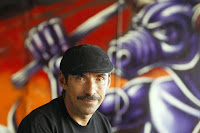Riding the Los Angeles Metro, I see what many people call vandalism of public property because they are hardly any form of art outside of initials scribbled behind billboards or walls. Of course, there are other more elaborate and colorful pieces. If you would like to see any of types of wall drawings, then all you need to do is jump on the blue line Metro train and head into downtown L.A.
At every train station and in every cab, there are graffiti hot lines you can use if you see anybody vandalizing public property to report it to police. There is a Web site dedicated to only graffiti removal
and information on where to call and report if you see graffiti throughout the city.
and information on where to call and report if you see graffiti throughout the city.
Some people consider graffiti a kind of litter of the city. However, as much as people paint on unauthorized public places, places like the Graff Lab should be utilized to keep at least some graffiti artists off the streets and on a legal public canvas for their painting pleasure.
The video below is a video from riding the Metro from first street station in Long Beach into downtown Los Angeles.
Music is by Lady Tron "Ghost"



















